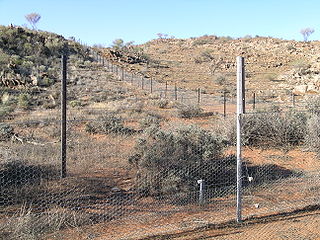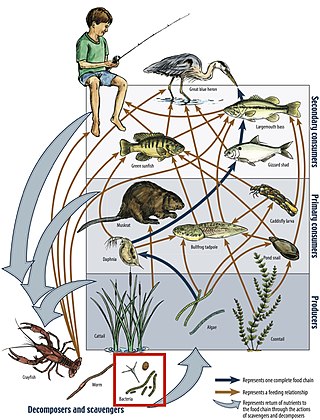Related Research Articles

Overgrazing occurs when plants are exposed to intensive grazing for extended periods of time, or without sufficient recovery periods. It can be caused by either livestock in poorly managed agricultural applications, game reserves, or nature reserves. It can also be caused by immobile, travel restricted populations of native or non-native wild animals.

A food web is the natural interconnection of food chains and a graphical representation of what-eats-what in an ecological community. Ecologists can broadly define all life forms as either autotrophs or heterotrophs, based on their trophic levels, the position that they occupy in the food web. To maintain their bodies, grow, develop, and to reproduce, autotrophs produce organic matter from inorganic substances, including both minerals and gases such as carbon dioxide. These chemical reactions require energy, which mainly comes from the Sun and largely by photosynthesis, although a very small amount comes from bioelectrogenesis in wetlands, and mineral electron donors in hydrothermal vents and hot springs. These trophic levels are not binary, but form a gradient that includes complete autotrophs, which obtain their sole source of carbon from the atmosphere, mixotrophs, which are autotrophic organisms that partially obtain organic matter from sources other than the atmosphere, and complete heterotrophs that must feed to obtain organic matter.

A keystone species is a species that has a disproportionately large effect on its natural environment relative to its abundance, a concept introduced in 1969 by the zoologist Robert T. Paine. Keystone species play a critical role in maintaining the structure of an ecological community, affecting many other organisms in an ecosystem and helping to determine the types and numbers of various other species in the community. Without keystone species, the ecosystem would be dramatically different or cease to exist altogether. Some keystone species, such as the wolf, are also apex predators.

Energy flow is the flow of energy through living things within an ecosystem. All living organisms can be organized into producers and consumers, and those producers and consumers can further be organized into a food chain. Each of the levels within the food chain is a trophic level. In order to more efficiently show the quantity of organisms at each trophic level, these food chains are then organized into trophic pyramids. The arrows in the food chain show that the energy flow is unidirectional, with the head of an arrow indicating the direction of energy flow; energy is lost as heat at each step along the way.

Kelp forests are underwater areas with a high density of kelp, which covers a large part of the world's coastlines. Smaller areas of anchored kelp are called kelp beds. They are recognized as one of the most productive and dynamic ecosystems on Earth. Although algal kelp forest combined with coral reefs only cover 0.1% of Earth's total surface, they account for 0.9% of global primary productivity. Kelp forests occur worldwide throughout temperate and polar coastal oceans. In 2007, kelp forests were also discovered in tropical waters near Ecuador.

The soil food web is the community of organisms living all or part of their lives in the soil. It describes a complex living system in the soil and how it interacts with the environment, plants, and animals.

An apex predator, also known as a top predator, is a predator at the top of a food chain, without natural predators of its own.

An urchin barren is commonly defined as an urchin-dominated area with little or no kelp. Urchin grazing pressure on kelp is a direct and observable cause of a "barren" area. However, determining which factors contribute to shifting a kelp bed to an urchin barren is a complex problem and remains a matter of debate among scientists.
Trophic cascades are powerful indirect interactions that can control entire ecosystems, occurring when a trophic level in a food web is suppressed. For example, a top-down cascade will occur if predators are effective enough in predation to reduce the abundance, or alter the behavior of their prey, thereby releasing the next lower trophic level from predation.
Ecological release refers to a population increase or population explosion that occurs when a species is freed from limiting factors in its environment. Sometimes this may occur when a plant or animal species is introduced, for example, to an island or to a new territory or environment other than its native habitat. When this happens, the new arrivals may find themselves suddenly free from the competitors, diseases, or predatory species, etc. in their previous environment, allowing their population numbers to increase beyond their previous limitations. Another common example of ecological release can occur if a disease or a competitor or a keystone species, such as a top predator, is removed from a community or ecosystem. Classical examples of this latter dynamics include population explosions of sea urchins in California's offshore kelp beds, for example, when human hunters began to kill too many sea otters, and/or sudden population explosions of jackrabbits if hunters or ranchers kill too many coyotes.

In ecology, a community is a group or association of populations of two or more different species occupying the same geographical area at the same time, also known as a biocoenosis, biotic community, biological community, ecological community, or life assemblage. The term community has a variety of uses. In its simplest form it refers to groups of organisms in a specific place or time, for example, "the fish community of Lake Ontario before industrialization".
An ecological cascade effect is a series of secondary extinctions that are triggered by the primary extinction of a key species in an ecosystem. Secondary extinctions are likely to occur when the threatened species are: dependent on a few specific food sources, mutualistic, or forced to coexist with an invasive species that is introduced to the ecosystem. Species introductions to a foreign ecosystem can often devastate entire communities, and even entire ecosystems. These exotic species monopolize the ecosystem's resources, and since they have no natural predators to decrease their growth, they are able to increase indefinitely. Olsen et al. showed that exotic species have caused lake and estuary ecosystems to go through cascade effects due to loss of algae, crayfish, mollusks, fish, amphibians, and birds. However, the principal cause of cascade effects is the loss of top predators as the key species. As a result of this loss, a dramatic increase of prey species occurs. The prey is then able to overexploit its own food resources, until the population numbers decrease in abundance, which can lead to extinction. When the prey's food resources disappear, they starve and may go extinct as well. If the prey species is herbivorous, then their initial release and exploitation of the plants may result in a loss of plant biodiversity in the area. If other organisms in the ecosystem also depend upon these plants as food resources, then these species may go extinct as well. An example of the cascade effect caused by the loss of a top predator is apparent in tropical forests. When hunters cause local extinctions of top predators, the predators' prey's population numbers increase, causing an overexploitation of a food resource and a cascade effect of species loss. Recent studies have been performed on approaches to mitigate extinction cascades in food-web networks.
Ecological extinction is "the reduction of a species to such low abundance that, although it is still present in the community, it no longer interacts significantly with other species".

The trophic level of an organism is the position it occupies in a food web. A food chain is a succession of organisms that eat other organisms and may, in turn, be eaten themselves. The trophic level of an organism is the number of steps it is from the start of the chain. A food web starts at trophic level 1 with primary producers such as plants, can move to herbivores at level 2, carnivores at level 3 or higher, and typically finish with apex predators at level 4 or 5. The path along the chain can form either a one-way flow or a food "web". Ecological communities with higher biodiversity form more complex trophic paths.

Lawrence Basil Slobodkin was an American ecologist and Professor Emeritus at the Department of Ecology and Evolution, Stony Brook University, State University of New York. He was one of the leading pioneers of modern ecology. His innovative thinking and research, provocative teaching, and visionary leadership helped transform ecology into a modern science, with deep links to evolution.
Nelson Hairston Sr. was an American ecologist. Hairston is well known for his work in ecology and human disease. In the field of ecology he is famous for championing the idea of the trophic cascade, on which he published the provocative “Green World Hypothesis” with colleagues Frederick E. Smith and Lawrence B. Slobodkin. Nelson was also deeply interested in the factors that control human disease and was an adviser to the World Health Organization for many years.

Overexploitation, also called overharvesting, refers to harvesting a renewable resource to the point of diminishing returns. Continued overexploitation can lead to the destruction of the resource, as it will be unable to replenish. The term applies to natural resources such as water aquifers, grazing pastures and forests, wild medicinal plants, fish stocks and other wildlife.
A food chain is a linear network of links in a food web, often starting with an autotroph, also called a producer, and typically ending at an apex predator, detritivore, or decomposer. It is not the same as a food web. A food chain depicts relations between species based on what they consume for energy in trophic levels, and they are most commonly quantified in length-the number of links between a trophic consumer and the base of the chain.

Salt marsh die-off is a term that has been used in the US and UK to describe the death of salt marsh cordgrass leading to subsequent degradation of habitat, specifically in the low marsh zones of salt marshes on the coasts of the Western Atlantic. Cordgrass normally anchors sediment in salt marshes; its loss leads to decreased substrate hardness, increased erosion, and collapse of creek banks into the water, ultimately resulting in decreased marsh health and productivity.

Compared to terrestrial environments, marine environments have biomass pyramids which are inverted at the base. In particular, the biomass of consumers is larger than the biomass of primary producers. This happens because the ocean's primary producers are tiny phytoplankton which grow and reproduce rapidly, so a small mass can have a fast rate of primary production. In contrast, many significant terrestrial primary producers, such as mature forests, grow and reproduce slowly, so a much larger mass is needed to achieve the same rate of primary production.
References
- ↑ Ceci, Samantha (20 August 2020). "The Green World Hypothesis".
- ↑ Allison, S. D. (23 March 2006). "Brown ground: a soil carbon analogue for the green world hypothesis?". The American Naturalist.
- ↑ Silliman & Angelini (2012). "Trophic Cascades Across Diverse Plant Ecosystems". Nature News.
- ↑ Paine, Robert T. (1 January 2013). "Frederick Edward Smith: 1920–2012". Bulletin of the Ecological Society of America. 94 (1): 20–23. doi: 10.1890/0012-9623-94.1.20 . ISSN 0012-9623.
- 1 2 Eisenberg, Cristina. "Living in a Landscape of Fear: How Predators Impact an Ecosystem". Scientific American. Retrieved 2023-09-13.
- ↑ "CHAPTER 3. Trophic Dynamics: Why Is the World Green?", CHAPTER 3. Trophic Dynamics: Why Is the World Green?, Princeton University Press, pp. 23–54, 2010-07-01, doi:10.1515/9781400834174.23/html, ISBN 978-1-4008-3417-4 , retrieved 2023-09-13
- ↑ Hairston, Nelson G.; Smith, Frederick E.; Slobodkin, Lawrence B. (November 1960). "Community Structure, Population Control, and Competition". The American Naturalist. 94 (879): 421–425. doi:10.1086/282146. ISSN 0003-0147.
- 1 2 "The Crucial Role of Predators: A New Perspective on Ecology". Yale E360. Retrieved 2023-09-13.
- ↑ Some Animals Are More Equal than Others: Keystone Species and Trophic Cascades , retrieved 2023-09-13
- ↑ admin-innovation (2006-02-28). "Ecologists explain why the world is green". Innovations Report. Retrieved 2023-09-13.
- ↑ "Predators Keep the World Green, Ecologists Find". Duke Today. 2006-02-28. Retrieved 2023-09-13.